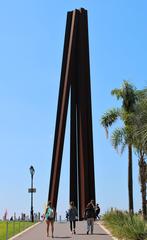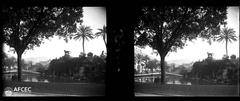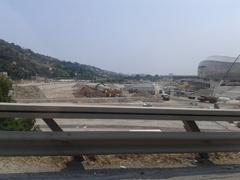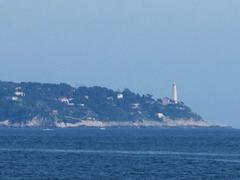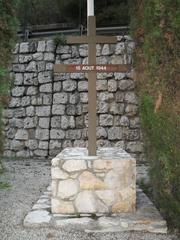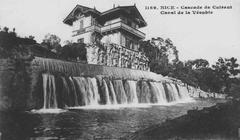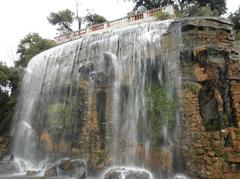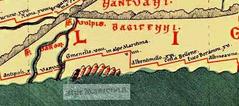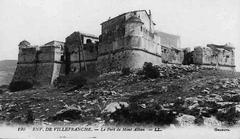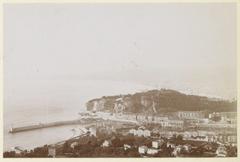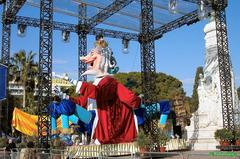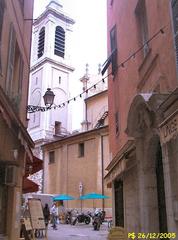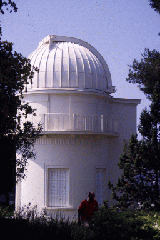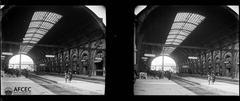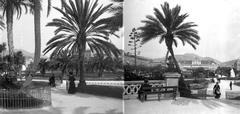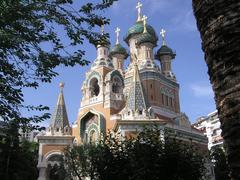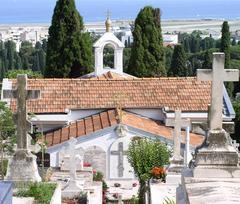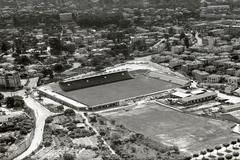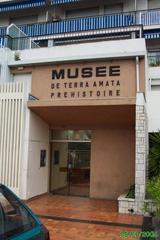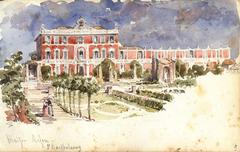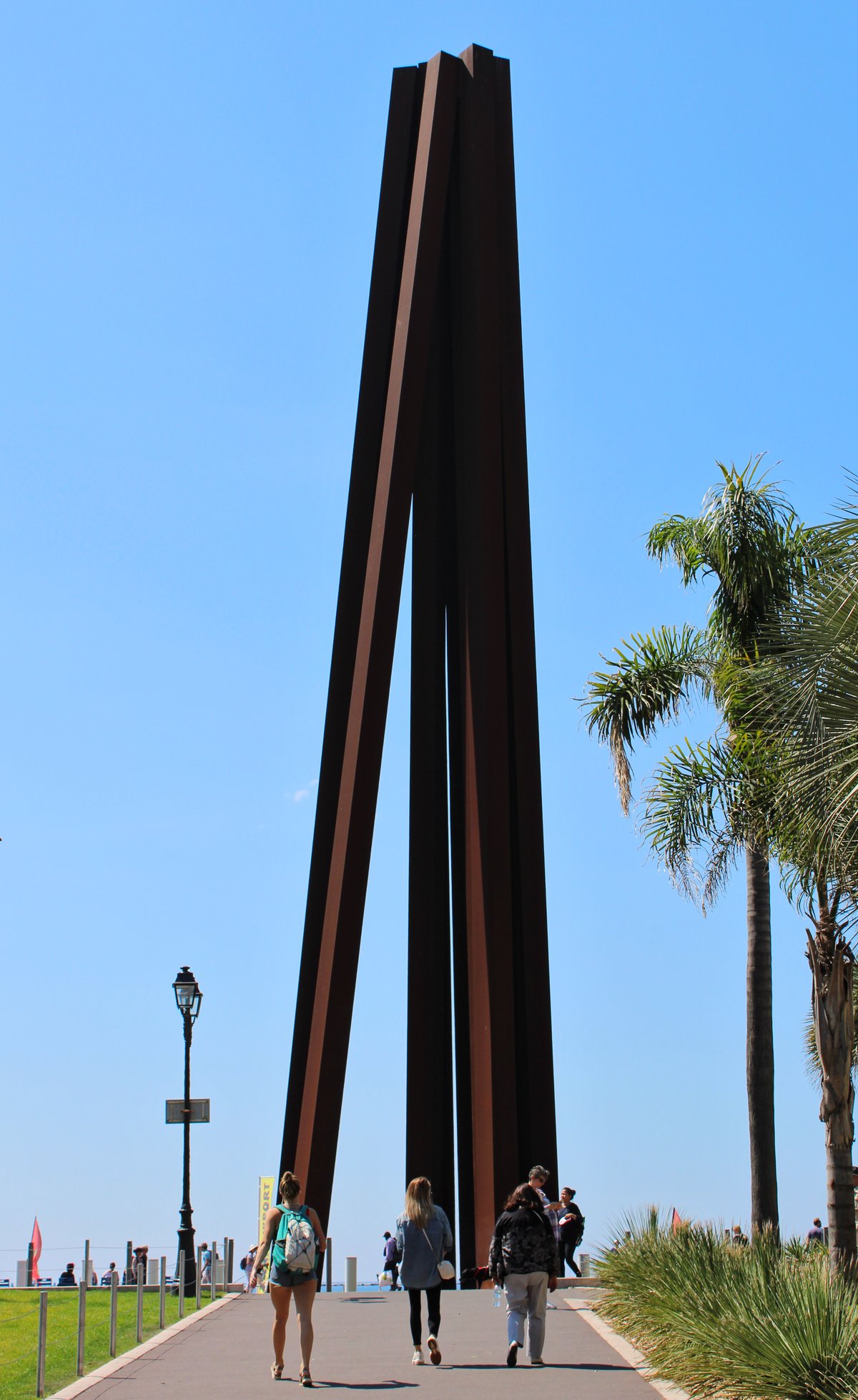
Visiting Neuf Lignes Obliques in Nice: Hours, Tickets, and Tips
Date: 24/07/2024
Introduction
Neuf Lignes Obliques, a monumental steel sculpture in Nice, France, stands as a significant cultural and historical landmark. Commissioned to commemorate the 150th anniversary of the annexation of the County of Nice by France in 1860, this striking artwork is a testament to the region’s rich heritage. The sculpture, designed by renowned French artist Bernar Venet, features nine 30-meter-long steel beams converging at their apex, symbolizing the unity and convergence of the nine valleys of the old County of Nice (Wikiwand). Located on the Promenade des Anglais, a historic and scenic walkway along the Mediterranean coast, Neuf Lignes Obliques is not only a piece of art but also a symbol of Nice’s integration into French territory (Haussmann Real Estate). This guide provides a comprehensive overview of the sculpture’s history, significance, and practical information for visitors, making it an essential resource for anyone planning to explore this iconic site in Nice.
Table of Contents
- Introduction
- History of Neuf Lignes Obliques
- Design and Construction
- Symbolism and Interpretation
- Visitor Information
- Inauguration and Relocation
- Historical Context - The Annexation of Nice
- The Role of Public Art in Nice
- The Promenade des Anglais
- The George Pompidou Esplanade
- Nearby Attractions
- Accessibility
- Impact on the Community
- FAQ
- Conclusion
History of Neuf Lignes Obliques
The Commissioning of Neuf Lignes Obliques
Neuf Lignes Obliques was commissioned to commemorate the 150th anniversary of the annexation of the County of Nice by France in 1860. This significant historical event marked the integration of Nice into French territory, a milestone celebrated through the creation of this monumental sculpture. The commission was initiated by Christian Estrosi, the Mayor of Nice, who sought to create a symbol that would encapsulate the historical and cultural essence of the region (Wikiwand).
The Artist - Bernar Venet
The artist behind Neuf Lignes Obliques is Bernar Venet, a renowned French sculptor known for his large-scale steel works. Venet, who grew up in Nice, was a fitting choice for this project due to his deep connection with the city. His artistic vision and expertise in monumental sculptures made him an ideal candidate to create a piece that would stand as a testament to Nice’s rich history and its integration into France (Haussmann Real Estate).
Design and Construction
The sculpture consists of nine steel beams, each 30 meters long, which converge at their top, forming a striking visual representation of oblique lines. The beams are made of 65 tonnes of corten steel, known for its weather-resistant properties, and are set on a 130-tonne concrete foundation. This robust construction ensures the sculpture’s durability against the coastal elements of Nice (Wikiwand).
Symbolism and Interpretation
While the nine beams are often interpreted as representing the nine valleys of the old County of Nice converging towards the sea, Venet himself has stated that his works possess their own identity and do not adhere to a defined symbolism. This ambiguity allows viewers to derive their own meanings from the sculpture, adding to its enigmatic allure (Haussmann Real Estate).
Visitor Information
- Visiting Hours: Neuf Lignes Obliques is accessible 24/7 as it is located in a public space.
- Tickets: There are no tickets required to view the sculpture as it is freely accessible.
- Location: The sculpture is prominently situated between the George Pompidou Esplanade and the Promenade des Anglais.
- Travel Tips: The best time to visit is during the early morning or late afternoon to avoid the midday sun. Consider bringing a camera to capture the sculpture from different angles.
Inauguration and Relocation
Neuf Lignes Obliques was inaugurated on May 31, 2010, in a ceremony that highlighted its significance as a cultural and historical landmark. Initially, the sculpture was placed at a different location but was moved 10 meters to its current site in 2012. This relocation was part of an effort to optimize its visibility and accessibility to the public (Wikiwand).
Historical Context - The Annexation of Nice
The annexation of Nice in 1860 was a pivotal moment in the region’s history. Prior to its annexation, Nice was part of the Kingdom of Sardinia. The Treaty of Turin, signed on March 24, 1860, facilitated the transfer of Nice to France, a move that was ratified by a plebiscite in April of the same year. This event marked the beginning of a new era for Nice, integrating it into the French nation and shaping its future development (Wikiwand).
The Role of Public Art in Nice
Neuf Lignes Obliques is part of a broader tradition of public art in Nice, which includes various sculptures, monuments, and installations that reflect the city’s rich cultural heritage. Public art in Nice serves not only as a means of beautification but also as a medium for historical and cultural expression. The presence of such artworks enhances the city’s aesthetic appeal and provides residents and visitors with a deeper understanding of its history and identity (Fortloc).
The Promenade des Anglais
The sculpture is prominently located on the Promenade des Anglais, a famous walkway along Nice’s Mediterranean coast. This location is significant as the Promenade des Anglais is a symbol of Nice’s cosmopolitan character and its appeal as a tourist destination. The promenade itself has a rich history, having been constructed in the 1820s by the English aristocracy who frequented Nice during the winter months. Today, it remains a central feature of the city’s landscape, attracting millions of visitors each year (Wikiwand).
The George Pompidou Esplanade
Neuf Lignes Obliques is situated between the George Pompidou Esplanade and the Promenade des Anglais. The esplanade, named after the former French President, is a public square on the south side of Vieux-Nice (Old Nice). This area is a hub of activity, offering a blend of historical charm and modern amenities. The esplanade’s proximity to the sculpture enhances its accessibility and visibility, making it a focal point for both locals and tourists (Wikiwand).
Nearby Attractions
While visiting Neuf Lignes Obliques, be sure to explore other nearby attractions:
- Castle Hill (Colline du Château): Offers panoramic views of Nice and the Mediterranean.
- Old Town (Vieux Nice): A maze of narrow streets filled with shops, cafes, and historical buildings.
- Nice Cathedral (Cathédrale Sainte-Réparate): A beautiful baroque cathedral located in the heart of Old Nice.
Accessibility
Neuf Lignes Obliques is easily accessible for visitors with disabilities. The surrounding area, including the Promenade des Anglais and George Pompidou Esplanade, features wide, flat pathways suitable for wheelchairs and strollers.
Impact on the Community
Since its installation, Neuf Lignes Obliques has become an integral part of Nice’s cultural landscape. It has sparked discussions and debates about the role of public art and its interpretation. The sculpture’s presence has also contributed to the city’s identity, serving as a landmark that commemorates a significant historical event while also embodying contemporary artistic expression (Haussmann Real Estate).
FAQ
- What are the visiting hours for Neuf Lignes Obliques? Neuf Lignes Obliques is accessible 24/7 as it is located in a public space.
- Where can I buy tickets for Neuf Lignes Obliques? There are no tickets required to view the sculpture as it is freely accessible.
- What is the significance of the nine beams in the sculpture? While often interpreted as representing the nine valleys of the old County of Nice, the artist, Bernar Venet, has stated that the sculpture does not adhere to a defined symbolism.
Conclusion
Neuf Lignes Obliques stands as a testament to the rich history and cultural heritage of Nice. Its commissioning, design, and installation reflect the city’s commitment to celebrating its past while embracing contemporary art. As a prominent feature on the Promenade des Anglais, the sculpture continues to captivate and inspire, offering a unique blend of historical significance and artistic innovation. Plan your visit today to experience this remarkable piece of public art.
References
- Wikiwand. (n.d.). Neuf Lignes Obliques. Retrieved from https://www.wikiwand.com/en/Neuf_Lignes_Obliques
- Haussmann Real Estate. (n.d.). Nine Oblique Lines. Retrieved from https://www.haussmannrealestate.com/blog/nine-oblique-lines/
- Fortloc. (n.d.). Promenade des Anglais. Retrieved from https://www.fortloc.com/pages/articles/travel/promenade-des-anglais/
- Trip.com. (n.d.). Neuf Lignes Obliques. Retrieved from https://www.trip.com/moments/poi-neuf-lignes-obliques-55840426
